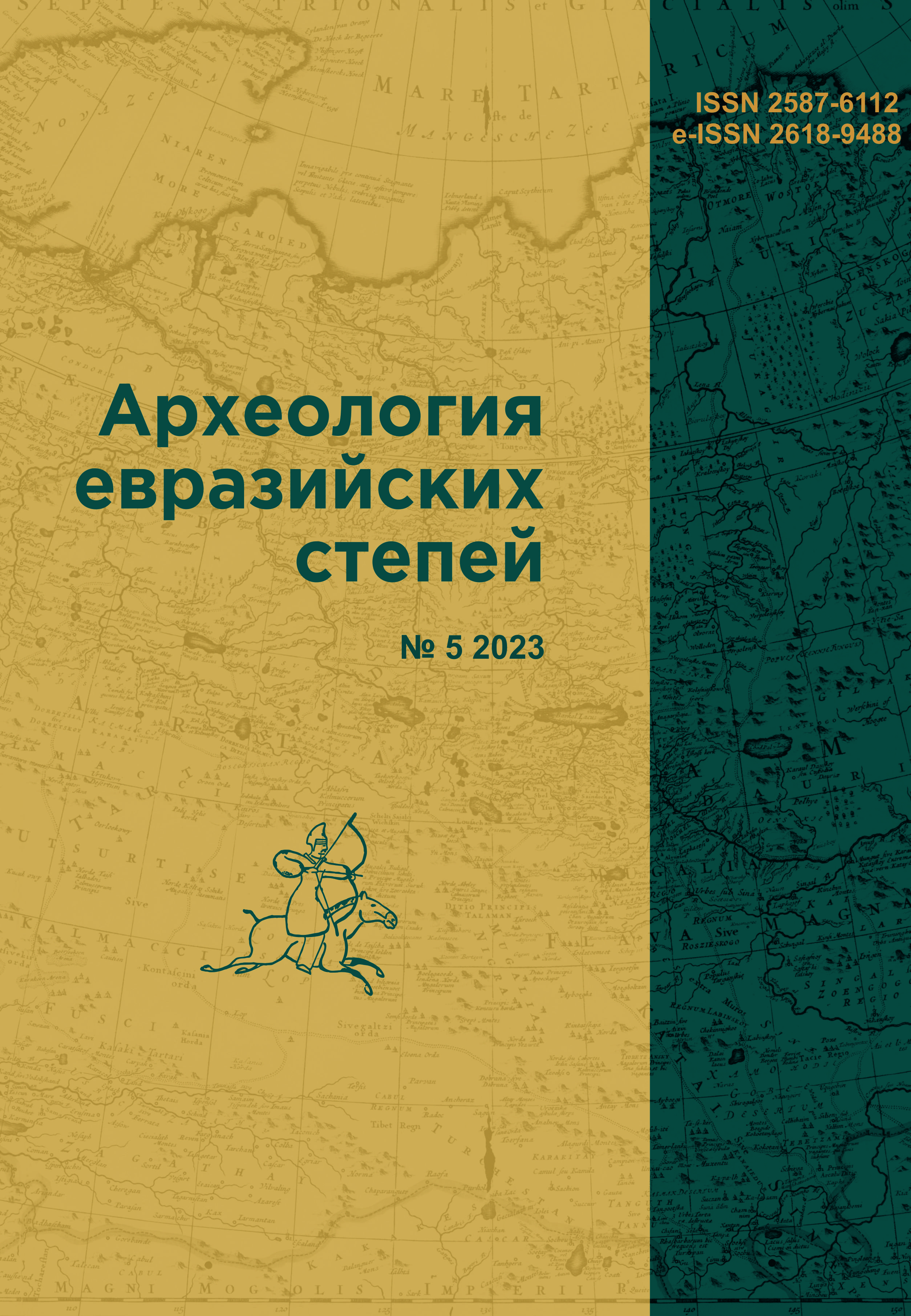Late Nomadic Burials with Muslim Rites in the Pokrovka IV Barrow Field in the Southern Ural
DOI:
https://doi.org/10.24852/2587-6112.2023.5.160.170Keywords:
archaeology of the Golden Horde, Ural River, Orenburg region, Islam, nomads, cairns.Abstract
At the end of the XIV – the very beginning of the XV centuries in the steppe and mountain-steppe zone of the Southern Ural, among the late nomadic population, religious dualism was practiced. According to the available archaeological data, barrow fields, containing both burials with a burial set typical for pagan nomads and with observance of such striking elements of pagan rituals as the burial of a horse, and burials with pronounced signs of Muslim rites (western orientation, absence of things, turning the head to the south, etc.), are known for the Golden Horde period in the steppes of the Ural-Volga region. The process of eradicating pagan traditions and replacing them with new rites can be traced most clearly in burial rituals. One of these monuments is the burial ground, considered in the article, located in the upper part of the Ural River in the east of the Orenburg region. Of the seventeen barrows, studied at the site, according to the set of signs of the burial rite, fourteen can be interpreted as Muslim ones. Spatial analysis of the monument shows that the pagan and Muslim burials, although they constitute a single necropolis, are located at a sufficient distance from each other. Pokrovka burial ground is not the only one in the region with such spatial structure (Ishkulovo II necropolis, near the settlement of Ural, etc.), which allows the authors to consider that adoption of Islam by the nomads of the Ural-Volga region was not a one-time phenomenon and covered a rather long period (XIV centuries). At the early stages, the spread of a new religion could be combined with traditional pagan burial rites, even within the same nomadic clan.
References
Bisembaev, A. A. 2010. Kochevniki srednevekov'ya Zapadnogo Kazakhstana (Medieval nomads of Western Kazakhstan). Aktobe: “Zhanadilov” Publ. (in Russian).
Vasilyev, D. V. 2009. Islamizatsiia i pogrebal’nye obriady v Zolotoi Orde (arkheologo-statisticheskoe issledovanie) (Islamization and Burial Rites in the Golden Horde: Archaeological and Statistical Research). Astrakhan: “Astrakhanskii universitet” Publishing House (in Russian).
Garustovich, G. N. 1987. Otchet ob arkheologicheskikh rabotakh v Meleuzovskom, Kugarchinskom, Chishminskom, Miyakinskom, Bishbulyakskom, i Zianchurinskom rayonakh Bashkirskoy ASSR po otkrytym listam formy 1 za №№406 i 407 v 1986 g. (Report on archaeological works in Meleuz, Kugarchinsky, Chishmy, Miyaki, Bishbuliak, and Zianchurinsky districts of Bashkir ASSR on excavation licenses of Form 1 for Nos. 406 and 407 in 1986). Archive of the archaeological laboratory of the Bashkir State Pedagogical Institute (in Russian).
Garustovich, G. N., Ivanov, V. A., Protsenko, A. S. 2014. In Izvestiia Samarskogo nauchnogo tsentra Rossiiskoi Akademii nauk (Proceedings of the Samara Scientific Center, Russian Academy of Sciences). Vol. 16, no. 3–2, 626–633 (in Russian).
Garustovich, G. N., Ivanov, V. A., Protsenko, A. S. 2015. In Vestnik Cheliabinskogo gosudarstvennogo universiteta. Istoriia. (Bulletin of the Chelyabinsk State University. History Series) 6 (361), 28–34 (in Russian).
Garustovich, G. N., Rakushin, A. I., Yaminov, A. F. 1998. Srednevekovye kochevniki Povolzh'ia (kontsa IX – nachala XV veka) (Medieval Nomads of the Volga Region (Late 9th – Early 15th Centuries)). Ufa: “Gilem” Publ. (in Russian).
Ivanov, V. A. 1985. Nauchnyy otchet ob arkheologicheskikh issledovaniyakh v Orenburgskoy oblasti v 1985 godu (Scientific report on archaeological studies in the Orenburg region in 1985).Archive of the Institute of Archaeology of the RAS, f. R-1, D. 10676 (in Russian).
Ivanov, V. A. 2015. Kochevniki Zolotoy Ordy (Nomads of the Golden Horde). Ufa: Bashkir State Pedagogical University (in Russian).
Ivanov, V. A., Kriger, V. A. 1988. Kurgany kypchakskogo vremeni na Yuzhnom Urale (XII–XIV vv.). (Barrows of the Kypchak time in the Southern Urals (12th –14th cc.). Moscow: “Nauka” Publ. (in Russian).
Ivanov, V. A., Lyubchanskii, I. E. 2003. In Yaminov, A. F. (ed.). Ufimskii arkheologicheskii vestnik (Ufa Archaeological Herald) 4. Ufa: “Gilem” Publ., 230–244 (in Russian).
Ivanov, V. A., Protsenko, A. S., Ruslanov, E. V. 2021. In Povolzhskaya arkheologiya (Volga River Region Archaeology) 38 (4), 94–107 DOI: https://doi.org/10.24852/ pa2021.4.38.94.107 (in Russian).
Ivanov, V. A., Ruslanov, E. V., Protsenko, A. S. 2022. In Nizhnevolzhskiy Arkheologicheskiy Vestnik (The Lower Volga Archaeological Bulletin) 21 (2), 243–258. DOI: https://doi.org/10.15688/nav.jvolsu.2022.2.14 (in Russian).
Kriger, V. A. 1984. In Ivanov, V. A. (ed.). Pamyatniki kochevnikov Yuzhnogo Urala (Monuments of the Nomads of the South Urals). Ufa: Bashkirian Branch, Academy of Sciences of the USSR, 102–116 (in Russian).
Kravets, V. V. 2005. Kochevniki Srednego Dona v epokhu Zolotoi Ordy (Nomads of the Middle Don in the Golden Horde Period). Voronezh: Voronezh State Pedagogical University (in Russian).
Matyushko, I. V. 2011. In Morgunova, N. L. (ed.). Arkheologicheskie pamiatniki Orenburzh’ia (Archaeological Sites of Orenburg Region) 9. Orenburg: Orenburg State Pedagogical University, 146–155 (in Russian).
Matyushko, I. V. 2016. In Izvestiia Samarskogo nauchnogo tsentra Rossiiskoi Akademii nauk (Proceedings of the Samara Scientific Center, Russian Academy of Sciences). Vol. 18, nr. 3, 153–160 (in Russian).
Nedashkovsky, L. F. 2011. In Vasilyev, D. V., Zeleneev, Yu. A., Sitdikov, A. G. (eds.). Dialog gorodskoi i stepnoi kul’tur na evraziiskom prostranstve (Dialog of Urban and Steppe Cultures on Eurasian Territory). Kazan; Astrakhan: Institute of History named after Shigabuddin Mardzhani of the Tatarstan Academy of Sciences, 231–235 (in Russian).
Ruslanov, E. V. 2022. In Arkheologiya evraziiskikh stepei (Archaeology of Eurasian Steppes) 3, 106–113. DOI: https://doi.org/10.24852/2587-6112.2022.3.106.113 (in Russian).

Downloads
Published
How to Cite
Issue
Section
License
Copyright (c) 2023 V.A. Ivanov, A.S. Protsenko, E.V. Ruslanov

This work is licensed under a Creative Commons Attribution-NonCommercial 4.0 International License.







